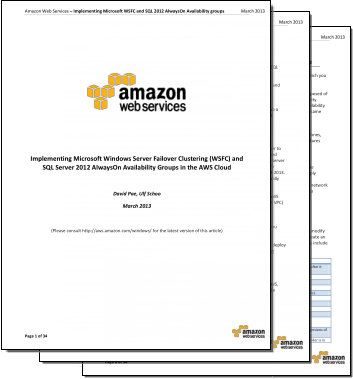AWS News Blog
Windows Wednesday – AWS Implementation Guide for Microsoft SQL Server 2012 AlwaysOn Availability Groups
|
|
Tom Rizzo is back with another guest post. Today he brings news of an implementation guide and some CloudFormation templates to show you how to implement SQL Server AlwaysOn Availability Groups.
— Jeff;
Welcome to another installment of Windows Wednesday! Last week we announced the beta of our AWS Diagnostics for Microsoft Windows Server which helps you diagnose and troubleshoot your AWS Windows Server deployments. This week, we wanted to discuss a topic that customers consistently ask us about in AWS when deploying Microsoft SQL Server: High Availability. Since many Windows customers use SQL Server as their database of choice, we wanted to make sure we were providing you with the best guidance on how to make your SQL Server deployments highly available. With versions of SQL Server prior to SQL Server 2012, AWS continues to support the Database Mirroring technologies to provide you with a highly available environment. SQL Server 2012 introduces the next generation of high availability by providing SQL Server AlwaysOn Availability Groups.
 Today, were proud to announce that in addition to Database Mirroring, we also support SQL Server 2012 AlwaysOn Availability Groups. To help you implement a highly available SQL Server deployment, we are releasing an AWS Implementation Guide for SQL Server 2012 AlwaysOn Availability Groups.
Today, were proud to announce that in addition to Database Mirroring, we also support SQL Server 2012 AlwaysOn Availability Groups. To help you implement a highly available SQL Server deployment, we are releasing an AWS Implementation Guide for SQL Server 2012 AlwaysOn Availability Groups.
The guide discusses architectural considerations and configuration steps when launching the necessary AWS services such as Amazon Elastic Compute Cloud (Amazon EC2) and Amazon Virtual Private Cloud (Amazon VPC) to run a Windows Server Failover Cluster (WSFC) cluster across different subnets and Availability Zones. In addition, the guide provides instructions for installing and configuring the WSFC cluster and an AlwaysOn availability group.
The guide also includes two sample AWS CloudFormation templates designed to help you deploy the necessary and correctly configured infrastructure and to do so predictably and repeatedly. Also, you can download a sample application that can test your cluster and allow you to see the failover occur between the different nodes in your deployment.
Here’s a video to help you get started:
— Tom Rizzo, General Manager, AWS Windows Team.
